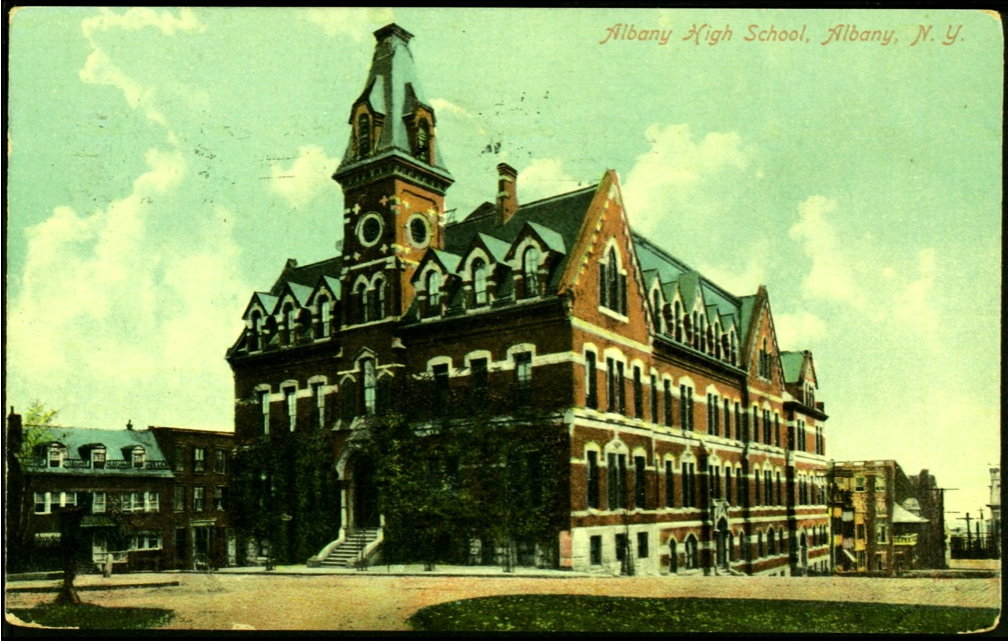As noted previously, in its earliest days Albany wasn’t exactly overrun with schools, and most of the first schools required tuition or patronage of some sort. In 1796, the Common Council passed an ordinance authorizing free schools, and then promptly did nothing about creating any. Joel Munsell’s Annals of Albany indicates that there were still no public schools in the city before 1810, when the idea of a Lancasterian school was apparently first raised. But there was some kind of academic explosion going on, as there were many individual teachers, both male and female, who were listed as teaching in Albany in 1813. They included Widow Catherine Goheen, Widow Esther Bedford, Widow Martha Wilson, several apparent non-widows, and a number of men, the health of whose spouses was not reported.
Howell, in his “Bi-centennial History of Albany,” wrote that “From 1830 to 1866, we can say little in commendation of the system of Public Schools in Albany. The importance of the subject does not seem to have been considered by the citizens. They kept pace neither with the growth of the city nor the demands of the times.” He noted that in 1833, there were 6,277 children of school age in the city, “of which number, 3,578 had been taught by thirty-four teachers.” A system of nine school wards in the city was created, and eight new school buildings were opened in 1838, but there was still a charge. “The children of those who were too poor to pay tuition were called charity scholars, and this degrading distinction prevented many from attending the schools. The right of free education was not recognized till 1862, when the odious system of school rates … was abolished.” Around this time, there were seventy private schools (many instructing only a few pupils), 13 public schools, and the academies. In 1857, the Wilberforce School opened with accommodation for 143 “colored children,” but ceased to be exist as a segregated school in 1874, when African American students were admitted to all schools.

Still, all of these schools were essentially grammar schools. “The inadequacy of the schools was clearly manifest, yet the opposition of the public to enlarge the school facilities by the expenditure of any large money, at a period of financial uncertainty consequent upon the close of the war, and already suffering under heavy taxation, was particularly strong.” Sound familiar? After some legal wrangling, the Board of Public Instruction opened the Free Academy, the city’s first version of a high school, in Van Vechten Hall on State Street in 1868. (Van Vechten had been built as the freight and passenger station for the first railroad, the Hudson and Mohawk.) The academy grew rapidly, and in 1873 came under the control of the Regents of the University and was renamed Albany High School.
A new building was erected in 1876, which Howell wrote stood “87 feet front on Eagle street, 135 feet 4 inches on Steuben, 120 feet on Columbia, and 92 feet and 7 inches wide on the rear. It comprises sub-cellar, basement and three stories above the basement. The superstructure is of Philadelphia pressed bricks, with light stone trimmings, interspersed with courses of black stone and white bricks, presenting an outward appearance singularly attractive and pleasing to the eye. Fortunate in its location, beautiful in appearance, and complete in all its appointments, it is one of the most perfect of its kind in the State.” It was designed by the Albany architects, Ogden & Wright, and cost about $140,000.
“The High School is still under the direction of John E. Bradley, its principal, a discreet manager and an able instructor. He is assisted by eight male instructors and twelve female teachers. In 1885, there were 608 scholars. The language studies pursued consist of Latin, Greek, German, French and English. The other branches are mathematics, chemistry, physics, drawing, vocal music, rhetoric and elocution, and the various English branches.”
The building continued in use until a new high school was constructed around 1915. While the Albany County Courthouse that replaced it in 1916 is certainly no econo-box, it’s hard not to lament the loss of this lovely Ogden structure.

Leave a Reply